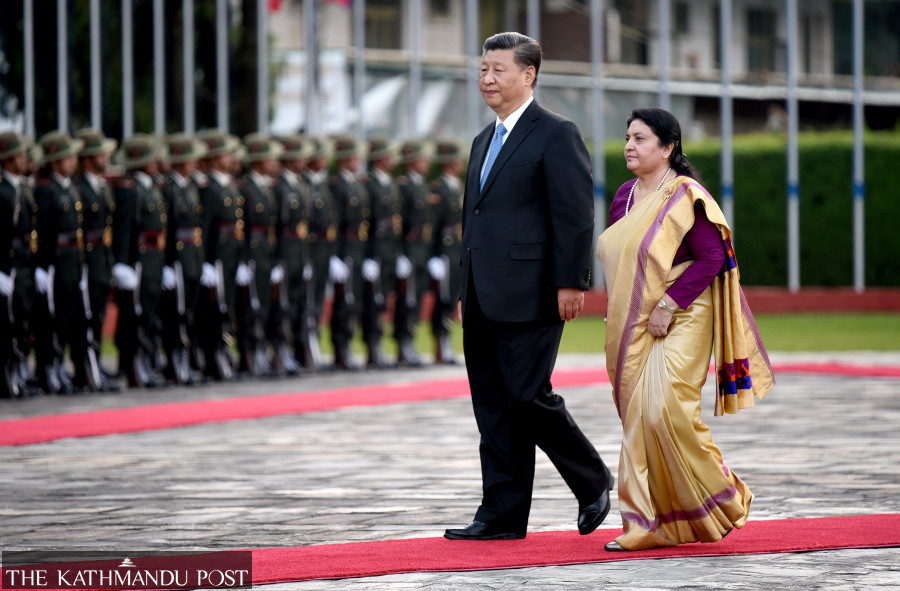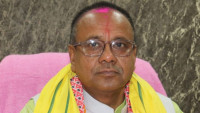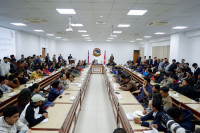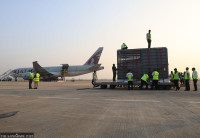National
Two years since Xi’s visit, Nepal-China ‘strategic partnership’ remains an enigma
During Xi’s Nepal visit in 2019, the two countries made some big announcements, but there has been little progress.
Anil Giri
It has been a little over two years since Nepal and China elevated bilateral ties to “strategic partnership”.
When Chinese President Xi Jinping concluded his Nepal visit on October 13, 2019, a joint communiqué issued by both sides said they “decided to, on the basis of the Five Principles of Peaceful Coexistence, Charter of the United Nations and principles of good neighbourliness, elevate Nepal-China Comprehensive Partnership of Cooperation Featuring Ever-lasting Friendship to Strategic Partnership of Cooperation.”
This was the first time that a joint communiqué issued by Nepal and China ever mentioned the phrase “strategic partnership”. But many wondered then what actually it entailed.
Two years down the line, foreign affairs experts and analysts are still wondering what “strategic partnership” between Nepal and China really means.
In the last two years, two sides have never sat and discussed the possible blueprint of the “strategic partnership” which was aimed at “development and prosperity” and neither side has discussed how to execute the agreements and pacts signed during Xi’s visit to Nepal, first by a Chinese president in 23 years.
At least two senior government officials told the Post that the status of the implementation of the accords and agreements reached during the four high-level visits in the last five years between the two countries, which were supposed to effect considerable shifts in Nepal-China ties, is in “a very pathetic state”.
One tangible development since Xi’s visit was in December last year when Kathmandu and Beijing jointly announced the new height of Mt Everest—at 8,848.86 metres—something that had remained contentious between the two countries. Even though there has been a flurry of visits from Beijing to Kathmandu over the last two years, there is nothing that can be described as something that consolidates the “strategic partnership” between the two countries, officials and analysts say.
The “strategic partnership” was for development and prosperity, according to Leela Mani Paudyal, a former ambassador to China. “The major objective of the strategic partnership was to strengthen and develop the country and fix the developmental agenda. Due to Covid-19, we could not make progress in some fields. But in terms of development per se, we could not execute some accords and agreements.”
That said, several accords and agreements signed even before Xi’s visit have also failed to make any progress.
Elevating the Nepal-China ties to the “strategic partnership” was in the making ever since KP Sharma Oli visited Beijing in 2016, hot on the heels of an Indian border blockade. During his visit to Beijing, while serving his first stint as prime minister, Oli signed a slew of agreements including the Transit and Transportation Agreement per which China had agreed to provide its seven sea and land ports for Nepal to use for third-country trade.
In April 2019, a little over a year after Oli returned to power, the two countries signed the protocol on implementing the Trade and Transit Agreement. But the two countries have not been able to develop even the standard operating procedure for implementing the transit agreement.
The agreement was touted as a game-changer for Nepal, as it would have broken the country’s near-complete dependence on India for third-country trade. The agreement was seen as a precursor to what is dubbed “strategic partnership”. To back that plan, there were other agreements between the two countries, including the Belt and Road Initiative, which was signed in May 2017.
“[But] we could not bring a single cargo via Chinese sea and land ports after signing the protocol,” said Paudyal, who served as Nepal’s ambassador in Beijing from 2016 to 2020.
Even two years after the announcement of the “strategic partnership”, it continues to be something of an enigma.
Analysts say no one knew two years ago what the “strategic partnership” meant and no one really knows what it means today. Over the last two years, Nepal’s politics, however, has undergone a sea change.
When Xi visited Nepal, flying from India on his way to Beijing, Nepal was governed by the Nepal Communist Party (NCP), a communist behemoth created by the union engineered by China between the CPN-UML and the Communist Party of Nepal (Maoist Centre).
But the infighting in the Nepal Communist Party (NCP) reached a tipping point and its split could not be stopped despite Chinese Ambassador Hou Yanqi personally visiting the top leaders. The party split in March this year as per a Supreme Court order. The Supreme Court in July defenestrated Oli from office and directed Nepali Congress President Sher Bahadur Deuba’s appointment as new prime minister. The Deuba government decided to form a committee “to study boundary issues” with China, which were dismissed by the previous Oli government.
Bilateral ties between Nepal and China have not hit any low that could be a cause for concern, say observers. But when it comes to the “strategic partnership”, they say there is not much to talk about.
Rupak Sapkota, deputy executive director at the Institute of Foreign Affairs, says ties, or the strategic partnership for that matter, get stronger based on how the two countries move forward their agreements and accords.
“The status of Nepal-China ties is not bad, but it’s true that in the wake of rapid political developments, there has not been much progress on the agreements the two countries had signed,” Sapkota told the Post.
According to him, various other factors have also come into play over the last few years.
“That the Covid-19 pandemic hit the world is known to everyone,” said Sapkota. “This led to some unease in ties between the United States and China. There was some closeness growing between the United States and India, just as the latter was having some border issues with China.”
Nepal unwittingly fell into geopolitical games in the wake of the Covid-19 pandemic, as the United States made a push for the Indo-Pacific Strategy, a security alliance believed to have been created to counter China’s growing influence.
Officials say the pandemic basically played the spoilsport, but there certainly could have been some groundwork for moving the agreements forwards, even if at a slow pace.
“I never heard or got sincere instructions in the last years to execute the past agreements and pacts,” said a government secretary who wished to remain anonymous citing the sensitivity of the matter. “Time and again, foreign ministers, foreign secretaries and oftentimes, some political leaders did commit to executing the agreements and pacts during virtual meetings in the time of the pandemic, but there has been no substantive progress.”
According to the secretary, the implementation of the pacts and agreements signed in the last four visits between Kathmandu and Beijing, including the BRI, has been poor and none of the ministries has taken them seriously.
“The major achievement was we jointly announced the new height of Mt Everest,” he said.
When Nepal and China announced that the bilateral ties had been elevated to “strategic partnership”, some believed it could have some security and military components. But there has been no clarity on that aspect as of now. The Treaty on the Mutual Legal Assistance on Criminal Matters was one of the instruments signed between Nepal and China during Xi’s visit.
Rajan Bhattarai, a CPN-UML leader who served as Oli’s foreign relations adviser, said the Covid-19 pandemic created some problems after Xi’s visit.
“We could not make tangible progress in infrastructure-related projects which were signed during the visit of President Xi,” Bhattarai admitted. “But we have completed several paperworks on the accords and agreements. If we could not show any concrete results, that’s because of the pandemic. It is true that projects under the infrastructure segment could not make any significant progress but we are hopeful that there will be good progress soon.”
Now that the current government led by Deuba itself is struggling, there are concerns if some tangible progress can be seen in the near future. Deuba is leading a coalition, which is a medley of parties that have divergent views and ideologies.
The fact that Nepal could not utilise the Rs56 billion in grants announced by the Chinese President Xi during the delegation-level talks with President Bidya Devi Bhandari on October 12, 2019, also makes many wonder whether the ties have indeed been elevated to the “strategic partnership.”
Some, however, say not all is lost.
“President Bhandari keeps on following up on what was agreed upon,” said Tika Dhakal, a senior press expert to the President. “It is the government of Nepal that should push for the implementation of the accords.”
Sapkota, the deputy executive director at the Institute of Foreign Affairs, said Nepal-China ties have remained good.
“Beijing’s continued cooperation with Nepal in the fight against the Covid-19 pandemic and its support to the government’s vaccination drives are great examples of how the two countries’ bilateral relations stand,” Sapkota told the Post. “Nepal-China relations are on an upward trajectory.”




 16.12°C Kathmandu
16.12°C Kathmandu















